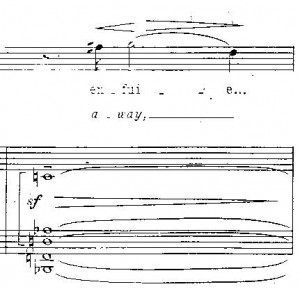Pelléas et Mélisande
Claudio Abbado, Wiener Philharmoniker
Pierre Boulez, Welsh National opera, subtítulos en español
w. Natalie Dessay, Russian subtitles
The version of Pelleas I had on record and got addicted with:
Danco/Mollet, Orchestre de la Suisse Romande, cond. Ernest Ansermet, Geneva 1952
I listened to almost nothing else for a year, played it on piano, sang it.. It was like my school of music. A lot of it uses just one note, or two notes, or a note moving around on top of two others, or two groups of two moving around etc, the harmonies arising naturally rather than being conventional chords – almost exploring every possible simple combination.
Once a few years later I was listening a lot to a Bismillah Khan raga using the scale D-Eb-F#-G#-A-Bb-C#-D – a very strange scale, I thought I’d never see it anywhere else. Then I opened the Pelleas score to a page with the exact same scale in the same key!
It’s a little scary/painful for me to listen to now.. Feels like brain surgery, exposing painful layers.. Too close to home. I overdosed, I guess. It’s “more myself than I am”..
Seinfeld: .. this orange dress.. just burned in my memory..
Kramer: ooh, memory burn! *grins*
– Seinfeld, S3E5
I remember reading a critic talking about how weird, unsettling and supermodern a particular root chord was in a particular spot in Pelleas.. I looked it up and found this! (see picture –> ) – a very typical Bb7 jazz voicing! Indeed it seems to me that what I call “jazz ears” – the way, mostly in a harmonic sense, I mean, I hear music – finding Mozart-type music harmonically dull, and atonal music too.. er, atonal – are an invention of Debussy: using all the notes of the scale, not just the triad (and sometimes sixth or seventh) but all the notes, experimenting, playing, using the pleasure of the ear to guide the music, and not the rules of tradition.
Chansons de Bilitis
I love these songs so much that I didn’t bother with Debussy’s earlier songs much after I discovered them.
Christa Ludwig
Régine Crespin with Enrique Ricci, 1969, Buenos Aires
Sonata for Flute, Viola and Harp, 1915
Sonata for violin and piano, 1916-7
David Oistrakh – violin, Frida Bauer – piano, 1972
Prélude a l’après-midi d’un faune – Prelude to the afternoon of a faun 1892-4
Sergiu Celibidache, Munich Philharmonic 1994
The Martyrdom of St Sebastian
I can’t find a good version on youtube in English… Probably there aren’t two versions the same. (I don’t mind Bernstein’s version, although he takes bizarre liberties with the Narrator’s words. When I bought that CD in Melbourne, the young music shop attendant tried to stop me, as if I was crazy. hehe.)
Apparently Debussy wrote this in weeks, and Caplet finished/orchestrated it for him. Has lots of wonderful bits, though; maybe the broad-brushstroke nature of that briskness suited this piece of lurid D’Annunziana. Louez le Seigneur!!
Charles Munch
Claudio Abbado
Daniele Gatti/Isabelle Huppert
Children’s Corner
I. Doctor Gradus ad Parnassum – II. Jimbo´s Lullaby – III. Serenade for the Doll – IV. The Snow is Dancing – V. The Little Shepherd – VI. Golliwog´s Cakewalk
Arturo Benedetti Michelangeli, piano – 1962
http://www.youtube.com/watch?v=hguZfdvT4sE
La Mer 1903-5
Riccardo Muti, Berlin Philharmonic 1995
Iberia 1905-8
String Quartet, 1893
Sheet music
3 Nocturnes 1897-9
1. Nuages, 2. Fêtes, 3. Sirènes (Clouds, Festivals, Sirens)
Sergiu Celibidache, Stuttgart Radio Symphony Orchestra
Preludes Book I
Arturo Benedetti Michelangeli, piano : Danseuses de Delphes 1:09 Voiles 4:29 Le vent dans la plaine 9:05 «Les sons et les parfums tournent dans l’air du soir» 11:25 Les collines d’Anacapri 15:20 Des pas sur la neige 18:43 Ce qu’a vu le vent d’ouest 23:40 La fille aux cheveux de lin 27:35 La sérénade interrompue 30:20 La cathédrale engloutie 33:14 La danse de Puck 40:08 Minstrels 43:32
Preludes Book II
Ilya Itin
Syrinx for solo flute
Emmanuel Pahud